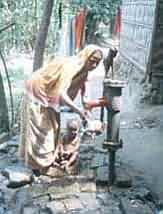Two US environment experts in an article blamed groundwater arsenic poisoning in Bangladesh on Farakka, Tista and other dams and barrages.

Thomas E. Bridge, Professor of Geology (emeritus) of Emporia State University, Kansas, USA and Meer T. Husain, Environmental Geologist, Kansas Department of Health and Environment in their article suggested that the natural groundwater flow that existed prior to 1975 should be restored by removing all dams and barrages that India constructed in the common rivers of Bangladesh and India.
"The removal of dams and barrages and the dredging of rivers will decrease the number of disasters in both Bangladesh and in the upstream region of India," according to the article titled, "Groundwater arsenic poisoning and a solution to the arsenic disaster in Bangladesh."
The experts believe that the oxidation of arsenopyrite or ferrous hydroxides rich in arsenic present in the Bengal Delta sediments may be responsible for the release of arsenic oxides in solution to the groundwater. The subsequent migration of this arsenic contaminated groundwater through these deltaic sediments may be one of the principal causes of arsenic poisoning in Bangladesh.
Arsenopyrite and ferrous hydroxides would be stable in the reducing environment below the groundwater table. If the groundwater table were lowered by increased irrigation during the dry season and the sediments exposed to the oxygen of the atmosphere, these arsenic rich minerals would oxidize, releasing arsenic.
The experts, however, apprehended that the flushing of arsenic contaminants might take a long time but opined that the removal of dams and barrages affecting Bangladesh would provide plenty of water during the dry season for drinking, irrigation and industry.
"The river water should be filtered, treated, continually tested and delivered through a closed system to provide a safe water supply for the nation," the article said.
A comprehensive plan not only for water supplies but associated waste disposal should be worked out for all of Bangladesh, the experts said, adding, individual units within the plan could be developed on the bases of need and tied into the overall plan as it develops.
 Related Information
Related Information
 Thomas E. Bridge, Meer T. Husain: Groundwater arsenic poisoning and a solution to the arsenic disaster in Bangladesh
Thomas E. Bridge, Meer T. Husain: Groundwater arsenic poisoning and a solution to the arsenic disaster in Bangladesh
 David Bradley: Arsenic Problem
David Bradley: Arsenic Problem
 West Bengal & Bangladesh Arsenic crisis info centre
West Bengal & Bangladesh Arsenic crisis info centre
 Related News
Related News
 UNESCO Courier, January 2002: Bangladesh’s arsenic poisoning: who is to blame?
UNESCO Courier, January 2002: Bangladesh’s arsenic poisoning: who is to blame?
 SARID, September 08, 2004: Arsenic Poisoning in Bangladesh by Jasmin Mehovic and Janaki Blum
SARID, September 08, 2004: Arsenic Poisoning in Bangladesh by Jasmin Mehovic and Janaki Blum
 EVISA, June 14, 2005: Arsenic concentration in groundwater may be affected by bacteria
EVISA, June 14, 2005: Arsenic concentration in groundwater may be affected by bacteria
last time modified: October 15, 2024